【课程大纲】《木材科学与工程专业外语》
- 格式:docx
- 大小:20.86 KB
- 文档页数:6
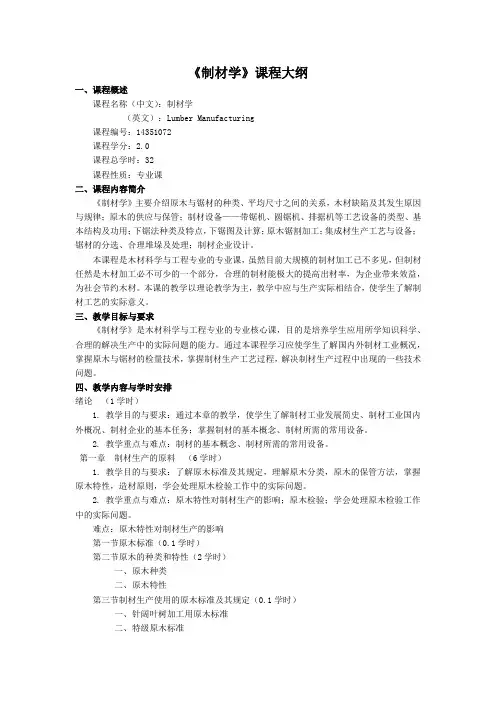
《制材学》课程大纲一、课程概述课程名称(中文):制材学(英文):Lumber Manufacturing课程编号:14351072课程学分:2.0课程总学时:32课程性质:专业课二、课程内容简介《制材学》主要介绍原木与锯材的种类、平均尺寸之间的关系,木材缺陷及其发生原因与规律;原木的供应与保管;制材设备——带锯机、圆锯机、排据机等工艺设备的类型、基本结构及功用;下锯法种类及特点,下锯图及计算;原木锯割加工;集成材生产工艺与设备;锯材的分选、合理堆垛及处理;制材企业设计。
本课程是木材科学与工程专业的专业课,虽然目前大规模的制材加工已不多见,但制材任然是木材加工必不可少的一个部分,合理的制材能极大的提高出材率,为企业带来效益,为社会节约木材。
本课的教学以理论教学为主,教学中应与生产实际相结合,使学生了解制材工艺的实际意义。
三、教学目标与要求《制材学》是木材科学与工程专业的专业核心课,目的是培养学生应用所学知识科学、合理的解决生产中的实际问题的能力。
通过本课程学习应使学生了解国内外制材工业概况,掌握原木与锯材的检量技术,掌握制材生产工艺过程,解决制材生产过程中出现的一些技术问题。
四、教学内容与学时安排绪论(1学时)1. 教学目的与要求:通过本章的教学,使学生了解制材工业发展简史、制材工业国内外概况、制材企业的基本任务;掌握制材的基本概念、制材所需的常用设备。
2. 教学重点与难点:制材的基本概念、制材所需的常用设备。
第一章制材生产的原料(6学时)1. 教学目的与要求:了解原木标准及其规定,理解原木分类,原木的保管方法,掌握原木特性,造材原则,学会处理原木检验工作中的实际问题。
2. 教学重点与难点:原木特性对制材生产的影响;原木检验;学会处理原木检验工作中的实际问题。
难点:原木特性对制材生产的影响第一节原木标准(0.1学时)第二节原木的种类和特性(2学时)一、原木种类二、原木特性第三节制材生产使用的原木标准及其规定(0.1学时)一、针阔叶树加工用原木标准二、特级原木标准三、小径原木标准四、次加工原木五、枕资第四节原木检验(2学时)一、原木的尺寸检量二、原木等级的评定三、原木材积计算第五节原木楞场和水上作业场(1.5学时)一、原木楞场的作业与管理二、原木楞场的工艺设计三、原木水上作业场第六节原木进车间前的准备(0.3学时)第二章制材生产的产品-锯材(5学时)1.教学目的和要求:了解制材产品标准及其规定,理解制材产品的保管原理与方法,掌握制材产品的分类及其检验方法,学会处理产品检验工作中的实际问题。
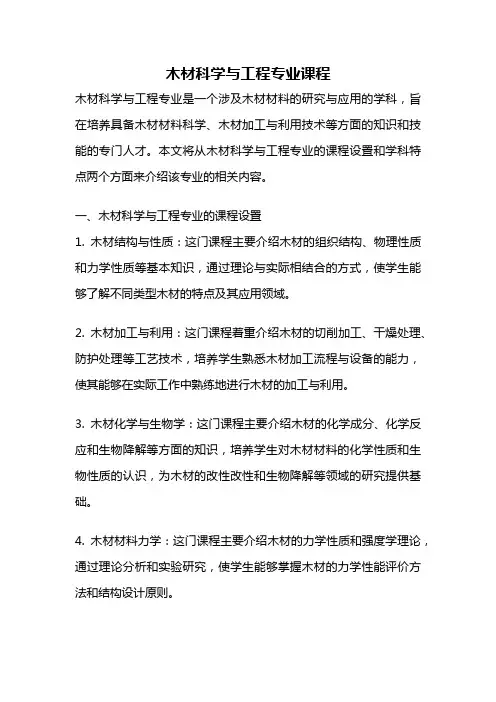
木材科学与工程专业课程木材科学与工程专业是一个涉及木材材料的研究与应用的学科,旨在培养具备木材材料科学、木材加工与利用技术等方面的知识和技能的专门人才。
本文将从木材科学与工程专业的课程设置和学科特点两个方面来介绍该专业的相关内容。
一、木材科学与工程专业的课程设置1. 木材结构与性质:这门课程主要介绍木材的组织结构、物理性质和力学性质等基本知识,通过理论与实际相结合的方式,使学生能够了解不同类型木材的特点及其应用领域。
2. 木材加工与利用:这门课程着重介绍木材的切削加工、干燥处理、防护处理等工艺技术,培养学生熟悉木材加工流程与设备的能力,使其能够在实际工作中熟练地进行木材的加工与利用。
3. 木材化学与生物学:这门课程主要介绍木材的化学成分、化学反应和生物降解等方面的知识,培养学生对木材材料的化学性质和生物性质的认识,为木材的改性改性和生物降解等领域的研究提供基础。
4. 木材材料力学:这门课程主要介绍木材的力学性质和强度学理论,通过理论分析和实验研究,使学生能够掌握木材的力学性能评价方法和结构设计原则。
5. 木材工程设计与实践:这门课程旨在培养学生的木材工程设计和实践能力,通过实践任务和课程项目,让学生运用所学知识解决实际问题,提高其工程实践能力。
二、木材科学与工程专业的学科特点1. 综合性:木材科学与工程专业涉及木材材料的多个方面,包括木材的结构与性质、加工与利用技术、化学与生物学等,具有较强的综合性和复合性。
2. 实践性:该专业注重学生的实践能力培养,通过实验教学、实习实训等方式,使学生能够熟练掌握木材加工与利用的技术,具备解决实际问题的能力。
3. 环保性:木材科学与工程专业在木材材料的应用和开发中,注重环境保护和可持续发展,倡导绿色、环保的木材加工与利用方式。
4. 应用性:木材是一种常见的建筑材料和装饰材料,木材科学与工程专业的学生在毕业后可以从事木材加工、家具设计、室内装饰等方面的工作,就业前景广阔。
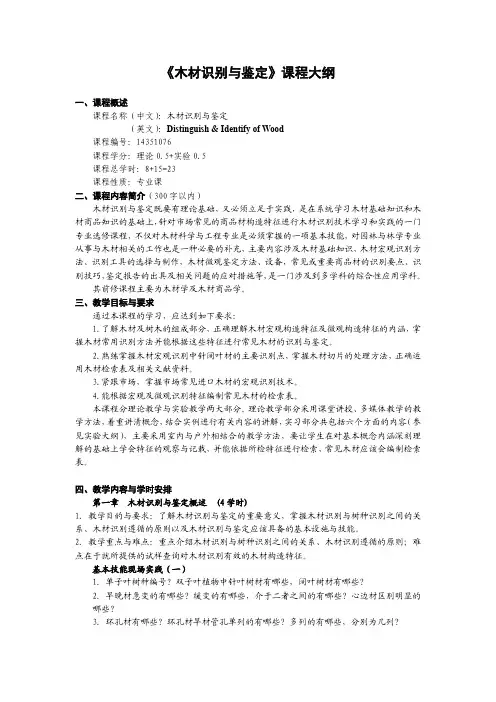
《木材识别与鉴定》课程大纲一、课程概述课程名称(中文):木材识别与鉴定(英文):Distinguish & Identify of Wood课程编号:14351076课程学分:理论0.5+实验0.5课程总学时:8+15=23课程性质:专业课二、课程内容简介(300字以内)木材识别与鉴定既要有理论基础,又必须立足于实践,是在系统学习木材基础知识和木材商品知识的基础上,针对市场常见的商品材构造特征进行木材识别技术学习和实践的一门专业选修课程,不仅对木材科学与工程专业是必须掌握的一项基本技能,对园林与林学专业从事与木材相关的工作也是一种必要的补充,主要内容涉及木材基础知识,木材宏观识别方法、识别工具的选择与制作,木材微观鉴定方法、设备,常见或重要商品材的识别要点、识别技巧,鉴定报告的出具及相关问题的应对措施等,是一门涉及到多学科的综合性应用学科。
其前修课程主要为木材学及木材商品学。
三、教学目标与要求通过本课程的学习,应达到如下要求:1.了解木材及树木的组成部分,正确理解木材宏观构造特征及微观构造特征的内涵,掌握木材常用识别方法并能根据这些特征进行常见木材的识别与鉴定。
2.熟练掌握木材宏观识别中针阔叶材的主要识别点,掌握木材切片的处理方法,正确运用木材检索表及相关文献资料。
3.紧跟市场,掌握市场常见进口木材的宏观识别技术。
4.能根据宏观及微观识别特征编制常见木材的检索表。
本课程分理论教学与实验教学两大部分。
理论教学部分采用课堂讲授、多媒体教学的教学方法,着重讲清概念,结合实例进行有关内容的讲解,实习部分共包括六个方面的内容(参见实验大纲),主要采用室内与户外相结合的教学方法,要让学生在对基本概念内涵深刻理解的基础上学会特征的观察与记载,并能依据所检特征进行检索,常见木材应该会编制检索表。
四、教学内容与学时安排第一章木材识别与鉴定概述 (4学时)1. 教学目的与要求:了解木材识别与鉴定的重要意义,掌握木材识别与树种识别之间的关系、木材识别遵循的原则以及木材识别与鉴定应该具备的基本设施与技能。

木材科学教研室(应用技能)课程大纲目录《电工学B》课程教学大纲 (1)《工程制图A》课程教学大纲 (6)《机械设计课程设计》教学大纲 (10)《机械设计基础》课程教学大纲 (13)《工程实训B》课程教学大纲 (23)《机械制造基础》课程教学大纲 (28)《理论力学》课程教学大纲 (35)《材料力学》课程教学大纲 (40)《企业管理案例》课程教学大纲 (46)《木材切削原理与刀具》课程教学大纲 (52)《木制品工艺学课程设计》课程设计教学大纲 (57)《木结构建筑学》课程教学大纲 (60)《木结构建筑材料学》课程教学大纲 (64)《胶粘剂与胶合技术》课程教学大纲 (71)《Art cam 设计与编程》课程教学大纲 (76)《数控加工操作实训》课程教学大纲 (79)《木材识别》课程教学大纲 (82)《涂料与涂饰技术》课程教学大纲 (85)《综合技能实训》课程教学大纲 (90)《专项技能实训》课程教学大纲 (93)《木材商品学》课程教学大纲 (99)《木材解剖及超微结构(双语)》课程教学大纲 (103)《毕业实习、设计(论文)》课程教学大纲 (107)《木材科学与工程专业导论》课程教学大纲 (110)《人造板工艺学课程设计》课程设计教学大纲 (114)《专业生产实习》课程教学大纲 (117)《定制家具设计》课程教学大纲 (121)《定制家具设计制作》课程教学大纲 (124)《木结构建筑结构学》课程教学大纲 (127)《数控雕刻设计与工艺》课程教学大纲 (132)《木材保护与改性技术》课程教学大纲 (137)《人造板监控与检测技术》课程教学大纲 (142)《木材学基础》课程教学大纲 (147)《木材干燥理论与技术》课程教学大纲 (152)《木材加工机械》课程教学大纲 (156)《木材加工机械操作》课程设计教学大纲 (160)《木工手工操作基础》课程教学大纲 (163)《木制品生产工艺学》课程教学大纲 (166)《木结构构件设计与制作》课程教学大纲 (171)《人造板制造学》课程教学大纲 (174)《木质材料表面装饰技术》课程教学大纲 (180)《电工学B》课程教学大纲一、课程基本属性二、课程简介与教学目标(一)课程简介电工学B是化学工程与工艺、木材科学与工程、材料科学与工程、生物工程、制药工程专业的一门专业基础核心课程。
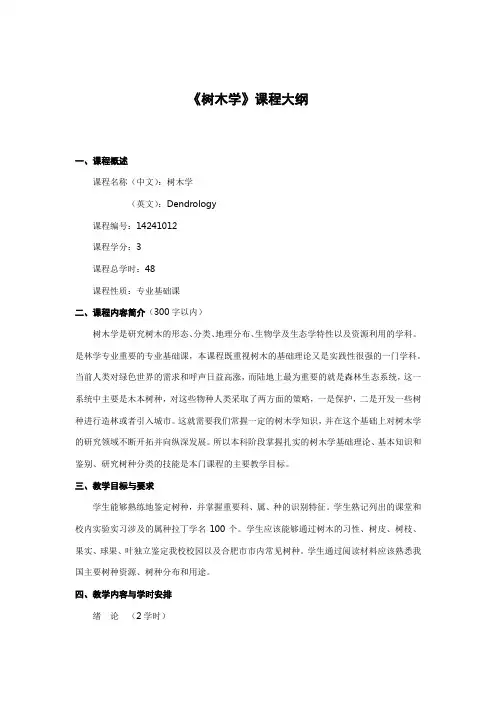
《树木学》课程大纲一、课程概述课程名称(中文):树木学(英文):Dendrology课程编号:14241012课程学分:3课程总学时:48课程性质:专业基础课二、课程内容简介(300字以内)树木学是研究树木的形态、分类、地理分布、生物学及生态学特性以及资源利用的学科。
是林学专业重要的专业基础课,本课程既重视树木的基础理论又是实践性很强的一门学科。
当前人类对绿色世界的需求和呼声日益高涨,而陆地上最为重要的就是森林生态系统,这一系统中主要是木本树种,对这些物种人类采取了两方面的策略,一是保护,二是开发一些树种进行造林或者引入城市。
这就需要我们常握一定的树木学知识,并在这个基础上对树木学的研究领域不断开拓并向纵深发展。
所以本科阶段掌握扎实的树木学基础理论、基本知识和鉴别、研究树种分类的技能是本门课程的主要教学目标。
三、教学目标与要求学生能够熟练地鉴定树种,并掌握重要科、属、种的识别特征。
学生熟记列出的课堂和校内实验实习涉及的属种拉丁学名100个。
学生应该能够通过树木的习性、树皮、树枝、果实、球果、叶独立鉴定我校校园以及合肥市市内常见树种。
学生通过阅读材料应该熟悉我国主要树种资源、树种分布和用途。
四、教学内容与学时安排绪论(2学时)1. 教学目的与要求:(1)理解树木、树木学以及一些相近的学科异同点,如,园林树木学、观棠树木学。
(2)理解树木学在林业生产中的作用:1. 林业基础生物学研究。
2. 林业生态建设的必须学科。
3. 森林植物资源开发利用。
(3)树木学的学习方法:《树木学》的特点是描述性强、涉及的树木种类多、名词术语多、需要记忆的内容多、树种的拉丁学名难记。
兴趣是学习树木学的最佳方法。
而且必须具备基本的植物学基础知识,包括一般《植物学》的植物微观形态知识和、《植物分类学》的宏观形态知识。
(4)树木学发展史:重点是理解树木学发展的历史,激发学生们的学习热情,认识到我国资源丰富,然而科研比较落后。
在新的历史时期,如何把现代生物科技术运用于树木学。
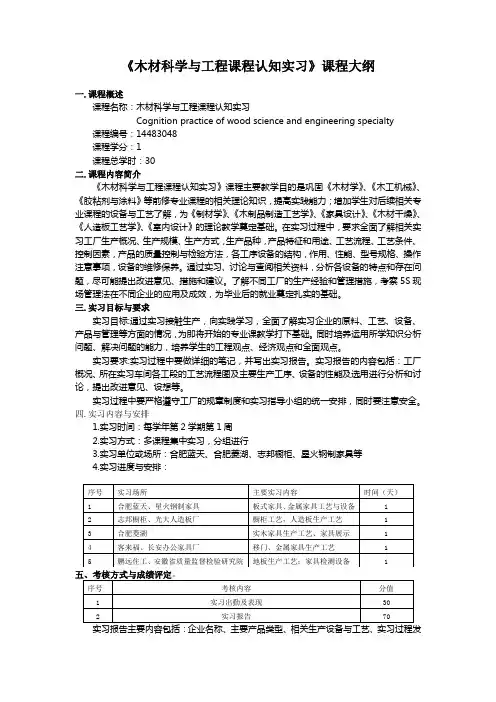
《木材科学与工程课程认知实习》课程大纲一.课程概述课程名称:木材科学与工程课程认知实习Cognition practice of wood science and engineering specialty 课程编号:14483048课程学分:1课程总学时:30二.课程内容简介《木材科学与工程课程认知实习》课程主要教学目的是巩固《木材学》、《木工机械》、《胶粘剂与涂料》等前修专业课程的相关理论知识,提高实践能力;增加学生对后续相关专业课程的设备与工艺了解,为《制材学》、《木制品制造工艺学》、《家具设计》、《木材干燥》、《人造板工艺学》、《室内设计》的理论教学奠定基础。
在实习过程中,要求全面了解相关实习工厂生产概况、生产规模、生产方式,生产品种,产品特征和用途、工艺流程、工艺条件、控制因素,产品的质量控制与检验方法,各工序设备的结构,作用、性能、型号规格、操作注意事项,设备的维修保养。
通过实习、讨论与查阅相关资料,分析各设备的特点和存在问题,尽可能提出改进意见、措施和建议。
了解不同工厂的生产经验和管理措施,考察5S现场管理法在不同企业的应用及成效,为毕业后的就业奠定扎实的基础。
三.实习目标与要求实习目标:通过实习接触生产,向实践学习,全面了解实习企业的原料、工艺、设备、产品与管理等方面的情况,为即将开始的专业课教学打下基础。
同时培养运用所学知识分析问题、解决问题的能力,培养学生的工程观点、经济观点和全面观点。
实习要求:实习过程中要做详细的笔记,并写出实习报告。
实习报告的内容包括:工厂概况、所在实习车间各工段的工艺流程图及主要生产工序、设备的性能及选用进行分析和讨论,提出改进意见、设想等。
实习过程中要严格遵守工厂的规章制度和实习指导小组的统一安排,同时要注意安全。
四.实习内容与安排1.实习时间:每学年第2学期第1周2.实习方式:多课程集中实习,分组进行3.实习单位或场所:合肥蓝天、合肥菱湖、志邦橱柜、星火钢制家具等4.实习进度与安排:实习报告主要内容包括:企业名称、主要产品类型、相关生产设备与工艺、实习过程发现的问题及企业优势、各实习企业综合分析、类似企业间比较分析、实习心得等,WORD 格式,附相关实习图片。
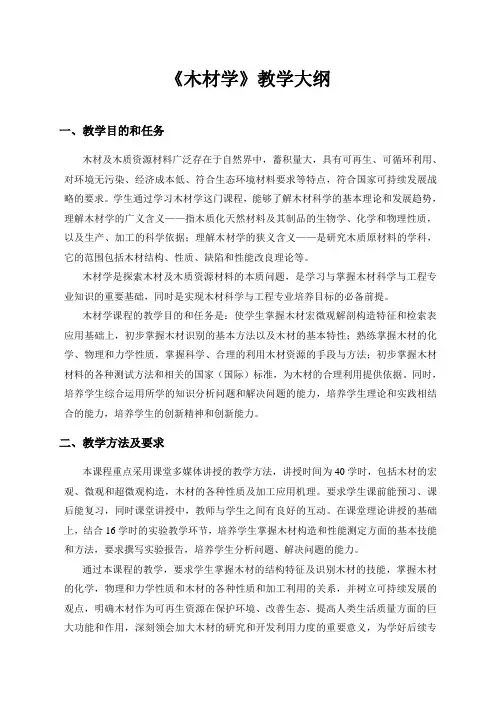
《木材学》教学大纲一、教学目的和任务木材及木质资源材料广泛存在于自然界中,蓄积量大,具有可再生、可循环利用、对环境无污染、经济成本低、符合生态环境材料要求等特点,符合国家可持续发展战略的要求。
学生通过学习木材学这门课程,能够了解木材科学的基本理论和发展趋势,理解木材学的广义含义——指木质化天然材料及其制品的生物学、化学和物理性质,以及生产、加工的科学依据;理解木材学的狭义含义——是研究木质原材料的学科,它的范围包括木材结构、性质、缺陷和性能改良理论等。
木材学是探索木材及木质资源材料的本质问题,是学习与掌握木材科学与工程专业知识的重要基础,同时是实现木材科学与工程专业培养目标的必备前提。
木材学课程的教学目的和任务是:使学生掌握木材宏微观解剖构造特征和检索表应用基础上,初步掌握木材识别的基本方法以及木材的基本特性;熟练掌握木材的化学、物理和力学性质,掌握科学、合理的利用木材资源的手段与方法;初步掌握木材材料的各种测试方法和相关的国家(国际)标准,为木材的合理利用提供依据。
同时,培养学生综合运用所学的知识分析问题和解决问题的能力,培养学生理论和实践相结合的能力,培养学生的创新精神和创新能力。
二、教学方法及要求本课程重点采用课堂多媒体讲授的教学方法,讲授时间为40学时,包括木材的宏观、微观和超微观构造,木材的各种性质及加工应用机理。
要求学生课前能预习、课后能复习,同时课堂讲授中,教师与学生之间有良好的互动。
在课堂理论讲授的基础上,结合16学时的实验教学环节,培养学生掌握木材构造和性能测定方面的基本技能和方法,要求撰写实验报告,培养学生分析问题、解决问题的能力。
通过本课程的教学,要求学生掌握木材的结构特征及识别木材的技能,掌握木材的化学,物理和力学性质和木材的各种性质和加工利用的关系,并树立可持续发展的观点,明确木材作为可再生资源在保护环境、改善生态、提高人类生活质量方面的巨大功能和作用,深刻领会加大木材的研究和开发利用力度的重要意义,为学好后续专业课程奠定必要的理论基础。
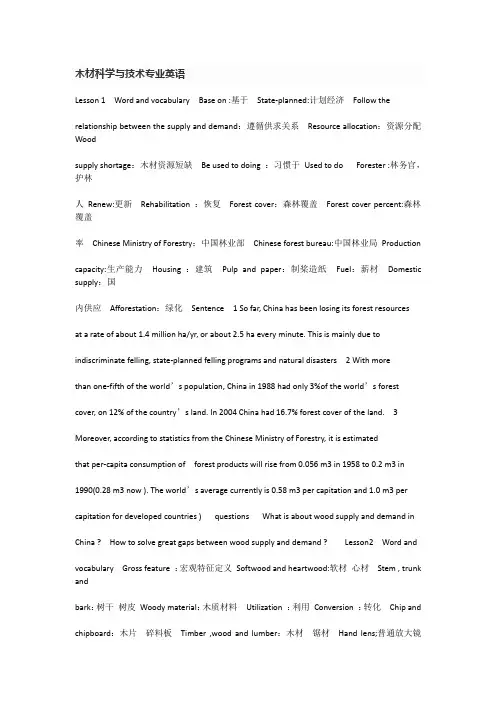
木材科学与技术专业英语Lesson 1 Word and vocabulary Base on :基于State-planned:计划经济Follow therelationship between the supply and demand:遵循供求关系Resource allocation:资源分配Woodsupply shortage:木材资源短缺Be used to doing :习惯于Used to do Forester :林务官,护林人Renew:更新Rehabilitation :恢复Forest cover:森林覆盖Forest cover percent:森林覆盖率Chinese Ministry of Forestry:中国林业部Chinese forest bureau:中国林业局Productioncapacity:生产能力Housing :建筑Pulp and paper:制桨造纸Fuel:薪材Domestic supply:国内供应Afforestation:绿化Sentence 1 So far, China has been losing its forest resourcesat a rate of about 1.4 million ha/yr, or about 2.5 ha every minute. This is mainly due to indiscriminate felling, state-planned felling programs and natural disasters 2 With morethan one-fifth of the world’s population, China in 1988 had only 3%of the world’s forest cover, on 12% of the country’s land. In 2004 China had 16.7% forest cover of the land. 3 Moreover, according to statistics from the Chinese Ministry of Forestry, it is estimatedthat per-capita consumption of forest products will rise from 0.056 m3 in 1958 to 0.2 m3 in 1990(0.28 m3 now ). The world’s average currently is 0.58 m3 per capitation and 1.0 m3 per capitation for developed countries ) questions What is about wood supply and demand in China ? How to solve great gaps between wood supply and demand ? Lesson2 Word andvocabulary Gross feature :宏观特征定义Softwood and heartwood:软材心材Stem , trunk andbark:树干树皮Woody material:木质材料Utilization :利用Conversion :转化Chip and chipboard:木片碎料板Timber ,wood and lumber:木材锯材Hand lens;普通放大镜Growthincrement, growth ring and growth layer:生长轮与annual ring 却别Consist of and becomposed of Woody cells 木细胞Physiological role:生理作用Patterns of distribution:分布形态Vary with:变化Longitudinally :纵向Make up:构成Bulk体积grain :纹理Xylem:木质部parenchyma and prosenchyma:薄壁组织和锐端细胞组织。
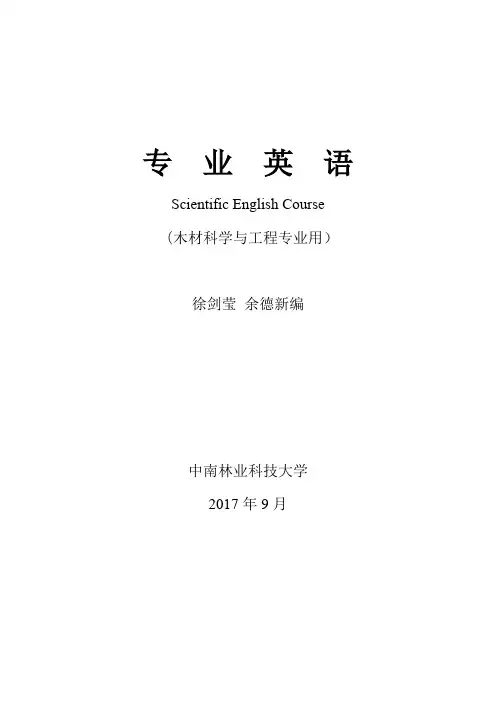
专业英语Scientific English Course(木材科学与工程专业用)徐剑莹余德新编中南林业科技大学2017年9月CONTENTS1. China: a country rich in tree species (1)2. Gross Structure of Wood (5)3. Microscopic Structure of Wood (10)4. Wood Cell-Wall Structure (14)5. Wood Chemical Components (18)6. Mechanical Properties of Wood (22)7. Deterioration of wood and wood products (27)8. The drying of wood (37)9. Drying Defects (45)10. Fiber Products (50)11. Plywood Production and Use (58)12. Particleboard and composite products (65)13. Furniture design (76)Lesson OneTextChina: a country rich in tree speciesChina has a total forest area of 208 million ha, covering 21.63% of its territory. The existing timber stock volume is about 15,100 million m3, equal to 11 m3 per capita.The forests are situated mainly in the Daxingan, Xiaoxingan and Changbai mountain ranges in the Northeast and Inner Mongolia; Fujian and Jiangxi Provinces in the East; Guangdong and Hunan Provinces and Guangxi Autonomous Region in Mid-south and Shennongjia in Hubei Province; Sichuan and Yunnan Province in Southwest and Tibetan Autonomous Region.From north to south, China‟s forests can be divided into coniferous belts in the frigid and temperate zones, mixed forest belts of coniferous, deciduous and broadleaf trees in the temperate zone, deciduous and broadleaf forest belts in the warm temperate zone, evergreen forest belts in the sub-tropical zone, and monsoon and rain forests in the tropical zone. Therefore, China is rich in tree species: there are more than 2,800 arbor species, of which about 1,000 are used for industry, 500 of these frequently.Some important industrial tree species are Korean pine, larch, spruce, fir, ash, basswood, birch, Chinese fir, masson pine, schima and castanopsis.Other valuable species are machilus, camphor and Chinese mahogany. Among the fast-growing species are paulownia and poplar, which are adaptable to the north and middle part of China. These trees, with diameters of about 40 cm at 10 years, can be used as timber. Chinese fir, which can be cut for timber at 20 years, is adapted to the broad area to the south of the Yangzi River. China also is rich in bamboo forest resources.New Words1. timber木材,木料2. log原木3. conifer […kounifә]针叶树4. conif erous [kou‟nifәrәs]针叶树的5. deciduous [di‟sidjuәs]落叶的6. broadleaf tree阔叶树7. pine松木8. Masson pine马尾松9. Korean pine红松10. larch [la:tʃ]落叶松11. spruce [spru:s]云杉12. Chinese fir杉木13. ash白蜡树14. bass-wood椴木15. birch桦木16. machilus润楠17. camphor […kӕmfә]樟木18. mahogany [mә‟hɔgeni]红木,桃花木19. schima木荷20. castanopsis栲树21. paulownia [pɔ‟louniә]泡桐22. poplar [pɔplә]杨木23. bamboo毛竹Lesson TwoTextGross Structure of WoodA mature tree, of either the softwood or the hardwood type, generally consists of a single stem which is covered with a layer of bark. This central trunk is the principal source of woody material for the manufacture of lumber and other products. While there is a trend toward the utilization of a greater portion of the tree, the conversion of tree tops and branches into usable material is done only where it is economically feasible. These parts can be converted into chips for pulping or for the manufacture of chipboard, but in many timber producing regions of the world they are considered to be waste and are left in the forest during a logging operation.The gross features of wood are those that are visible to the naked eye or with the aid of a hand lens. Characteristics such as growth increments, sapwood heartwood difference, wood rays and cell distribution patterns can be recognized at this level.1.Cellular CompositionA tree trunk is composed of millions of individual woody cells. These cells differ in size and shape, depending upon their physiological role in the tree, most of them being many times longer than broad. They are arranged on recognizable patterns of distribution within the wood, the organization varying with the species. The long cells which are arranged longitudinally make up the b ulk of the wood and provide “grain” to the material.Cells of the xylem or wood portion of the tree are of two general types, parenchyma and prosenchyma. Parenchymatous cells are food storage elements and must, therefore, remain alive for a longer period than prosenchymatous cells which lose their protoplasm the year in which they are formed. Parenchymatous cells are found in wood rays, as longitudinal or axial parenchyma, and as epithelial cells surrounding resin canals. The term prosenchyma may be applied to all of the other types of cells in mature wood, whether their major physiological role in the living tree may have been conductive or supportive.2.Wood RaysThere are also shorter cells in the tree, cells which areoriented perpendicular to the longitudinal elements andorganized into bands of tissue called wood rays. The cellsfound in wood rays are predominantly parenchyma cells,specialized for food storage, but the rays of some coniferscontain prosenchymatous cells. The presence and structure ofthis type of element (ray tracheid), the height, the width andthe composition of the ray are features frequently useful forthe identification of a wood species.Rays extend radially from the pith, at the center of thestem, to the cambium at the outer periphery of the xylem(wood), and continue into the phloem (bark). Depending onthe manner in which a log is cut, these ribbons of tissuecontribute to the natural figure of lumber and veneer. Woodsplits easiest along the grain and particularly in the plane ofthe wood rays.3.Planes of WoodWhen discussing structural elements and features of wood, it is convenient to specify the aspect or viewpoint with respect to three planes, cross or transverse, radial, and tangential. By cutting across the stem perpendicularly, a surface is exposed which is called a cross or transverse section. A radial section results from cutting longitudinally in the plane of the wood rays, from the pith to the bark. The plane which is perpendicular to the rays and tangent to the bark is called the tangential section. These planes and some of the gross features of wood are illustrated in Fig.1.4End grain and rays are visible on the cross section. This is also the aspect for viewing growth increments as concentric rings. The extent of heartwood development can also be observed in this plane, but both features can be seen on a radial section as well. Ends of rays appear on the tangential section and the pattern formed by them on this surface provides diagnostic evidence in some instances. Rays on the radial section give the appearance of broken ribbons and, depending on their size and contrast, may produce distinctive patterns.The vascular cambium is located at the xylem-phloem interface and is the initiating layer for both of these tissue systems. At the gross level this layer can barely be detected since it is but a few cells wide.4.Sapwood and HeartwoodThe sapwood-heartwood pattern is one of the most obvious features that can be observed on the cross or radial section of a mature tree trunk. Although not as pronounced in all species, most trees have an inner core of dark colored wood, heartwood, and an outer shell of light colored tissue called sapwood. This contrast in color has physiological significance in a general way, but it is not strictly correct to designate the core as heartwood only on the basis of its darker color. A more accurate criterion for heartwood determination is the absence of living cells within the zone, and in particular, cells of ray parenchyma which remain alive far longer than the neighboring prosenchymatous element. For commercial purposes, however, color is the determining factor used for the separation of sapwood from heartwood.Certain characteristic differences can be found between the sapwood and heartwood of the same tree. For example, weight, durability and permeability are often quite different and can be related to the changes which accompany sapwood-heartwood transformation. Reference to permeability differences will be made in the section dealing with pit membranes.5.Growth IncrementsAnother feature which is readily observed on the cross section is the growth increment. The boundaries of these increments are usually related to annual growth in trees grown in temperate climates. In tropical regions, however, growth increments can be the result of wet and dry seasons and the term “annual ring” often used for timbersfrom temperate zones would not be strictly applicable.The nature of the growth layer can be a helpful feature in the identification of wood. In temperate zone hardwoods, for example, patterns can often be observed with the unaided eye, if one examines the tissue within one annual increment. These patterns can be attributed to the size and distribution of pores, the term given to vessel openings as seen in cross section. When the pores in the earlywood are much larger than those formed later in the season, and when the size transition between earlywood and latewood pores is abrupt, the wood is classed as ring porous. If little or no transition in pore size exits between early-and latewood, the term diffuse porous is applied. Semi-ring porous or semi-diffuse porous are used to describe wood in which the pore patterns are not distinctly of the ring porous nor of the diffuse porous type. The three conditions are illustrated in Fig.1.6.New Words and Expression1. gross structure 宏观构造, 粗视构造2. mature tree 成熟林3. softwood 软材hardwood 硬材4. stem 树干5. bark 树皮6. trunk 树干7. chip 木片chipboard 碎料板8. pulp 浆料pulping 制浆9. logging 采伐10. growth layer 年轮, 生长层, 生长轮growth ring 年轮11.sapwood 边材heartwood 心材12. wood ray 木射线13. cell distribution pattern 细胞排列类型14. xylem [zailem] 木质部15. parenchyma [pә‟reŋki:mә]薄壁组织16. prosenchyma [p rou‟seŋki:mә]锐端细胞组织prosenchymatous cell 锐端细胞17. protoplasm [ 'prәutәplæzәm ] 原生质, 细胞质18. resin canal=resin duct 树脂道19. epithelial[ ,epi'θi:ljәl ] cell 分泌细胞20. tracheid [ 'treikiid ] 管胞21 cambium […kӕmbiәm]形成层22. phloem […flouem]韧皮部23. grain 纹理24. pith 髓(心)25. pit 纹孔26. pit membrane […membrein]纹孔膜27. ring-porous wood 环孔材28. diffuse porous wood 散孔材Lesson ThreeTextMicroscopic Structure of WoodMost of the gross structural features of wood considered in the previous sections have their origin in the sorting and arrangement of the various cell types found in wood. When thin sections of wood are examined with a light microscope, cellular composition can readily be observed. The cells are held together by inter-cellular substance, but should this middle lamella be dissolved through chemical treatment, the cellular composite is separated into individual elements. This, in fact, is the commercial process known as pulping which is employed to produce fibers for paper manufacture. Microscopic examination of pulp samples of hardwood and of softwood reveals that there are significant differences in the sizes and shapes of cells from these two sources.Major Cell TypesAs was mentioned earlier, wood contains parenchyma and prosenchyma. Parenchyma cells in softwood do not differ greatly from those found in heartwood. They are generally short, thin-walled cells with simple pits. Their shape can be quite variable, but in the wood rays, where most parenchyma is located, they are predominantly brick-shaped, particularly in coniferous wood. In softwoods, parenchyma forms but a small portion of the total woody tissue, less than five percent of the total volume in some species, probably averaging 7 to 8% for all conifers. In some hardwoods, parenchyma may form as much as one-third of the wood volume. This occurs in woods having aggregate or oak-type rays, but the average for hardwoods is less than 20%, or more than double that of the softwoods.The tissue of softwoods is simpler from the standpoint of variety of cell types. Besides the parenchyma in the wood rays, resin canals and longitudinal tracheids make up as much as 95% of the total wood volume of some coniferous species. These are long, imperforate cells having walls which may be thich or thin, depending on location of the cell in the growth increment. In cross section, tracheids are polygonal in shape, more or less square in earlywood and flattened radially in the latewood. In compressionwood, tracheids are more or less rounded in transverse section.Compared with the prosenchymatous elements of hardwood, coniferous tracheids are very long. In some species they are 7 mm or more in length. This feature makes wood of the conifers more desirable for paper manufacturing because it contributes to greater paper strength.Ray tracheids appear in the wood of some conifers, usually at the upper or lower margins of the wood rays, but in some cases the ray may consist solely of this type of cell. These prosenchymatous elements have bordered pits that are smaller than those found in the longitudinal tracheids and which distinguish them from the ray parenchyma cells which have only simple pits. In the hard pines, ray tracheids contain dentate thickenings on their inner walls. Ray tracheids do not occur in woods of the angiosperms.The vessel is the distinctive tracheary structure of the hardwoods. As viewed in cross section, where it is called a pore, it has a larger lumen than other cell types. Individual vessel elements are tubular, open-ended cells which, when joined end-to-end, form the vessel. They are relatively thin-walled cells specialized for conduction longitudinally in the tree. Extensive pitting is typical of most vessel walls, these openings providing for lateral conduction to neighboring cells. As viewed on the cross section, pores may be arranged in clusters, chains, multiples or as solitary openings. Grouping is sometimes of diagnostic significance.Vessel elements vary in size and shape depending upon the wood species and upon location in the growth increment. Vessels of the springwood in the ring-porous woods are of large diameter while those of the summerwood are quite small. In diffuse-porous woods, vessel diameters are nearly uniform across the growth ring. The variability in size and shape of vessel elements is illustrated in Fig.1.12b, d and e.A cell type of completely different appearance than the vessel element is the libriform fiber. This type of element is thick-walled, narrow-lumened and elongated. It is adapted for strength and support rather than conduction since it has imperforate tapered ends and small, slit-like, simple pits.In addition to these two specialized hardwood prosenchymatous elements, there are others which have features that would indicate a dual role in the living tree, involving both conduction and support. Tracheids or fiber-tracheids, similar in appearance to coniferous tracheids though shorter in length, (ca. 1.5mm), are relatively thick-walledwith bordered pits. Vascular tracheids resemble small vessel elements, but the ends of the cells are imperforate. Vasicentric tracheids are more fiber-like, but are nevertheless short, thin-walled and irregular-shaped. They also have bordered pits.On a weight basis, coniferous tracheids make up 97.8% of the wood of pinus sylvestris (PERILA and HEITTO, 1959) and an equal amount in Picea abies. Therefore, the parenchyma constitute a small percentage of the weight of softwood and only about 7% of the volume.In hardwoods there is wide variation in the proportions of cell types. PERILA found that the fibers of Betula verrucosa make up 86.1% of the weight of the wood, the vessels 9.3%, and the parenchyma cells 4.6%. volumetric data for this species are not available, but in Betula lutea, the fibers make up 63.8%, the vessels 21.4% and the parenchyma 12.8%. In a more porous species, Tilia Americana L., the vessels form as much as 55.6% of the volume of the wood, the fibers 36.1%, and the total parenchyma volume is only 8.3%, a small amount for a hard wood. At the other extreme, the vessels of Hicoria ovata (now Carya ovata) constitute only 6.5% of the total wood volume, while parenchyma totals 28% and fibers 66.5%New Words1. aggregate [ 'ægrigeit ] rays 聚合射线2. Longitudinal tracheid 轴向管胞3. ray tracheid 射线管胞4. margin 边缘5. dentate […denteit] thickenings锯齿状加厚6. angiosperm 被子植物7. bordered-pit 具缘纹孔8. distinguish[ dis'tiŋgwiʃ ] 区别, 识别, 辨别9. distinctive 区别性的, 有特色的, 与众不同的10. lumen […lu:min]细胞腔(单)lumina […lu:minә]细胞腔(复)11. lateral 侧向的12. cluster 一串, 一束, 一群, 一组13. multiple pores 复管孔14. ring-porous wood 环孔材15. diffuse-porous wood 散孔材16. libriform [laibraifɔ:m] fiber 木纤维, 韧性纤维17. imperforate [im‟pә:fәrit]无孔隙的, 不穿孔的Lesson FourTextWood Cell-Wall StructureOne must delve deeply into the structure of wood to understand its basic nature. Examination with a light microscope will reveal the details of pit and wall structure essential to making identifications at the species level. Even greater detail of the wall structure is revealed by the higher resolving power of the electron microscope. These observations are not only useful for identification but also essential to our understanding of the relationships between wood structure and its properties and behavior.Examination at the higher levels of magnification, as shown in Figure 3.14, reveals the cell wall to be composed of a number of layers. The neighboring cells are joined together by a lignin-rich layer known as the middle lamella. This layer is dissolved in a chemical pulping process to separate the wood into pulp fibers. The main structural components of the cell wall are threadlike elements called microfibrils, which are organized and oriented differently in each layer of the cell wall.Primary WallThe thin, outermost layer of the cell wall, which is formed first during the development of the cell, is known as the primary wall (p). The microfibrils in this wall are arranged irregularly in flat helixes. As the cell reaches full size, the wall is thicken by the addition of a three-layered secondary wall laid down from inside the cell. The layers of the secondary wall are numbered consecutively: s1 is closest to the outside primary wall, s2 makes up the bulk of the cell wall, and s3 is nearest the inside lumen of the elongated tracheid cell.S1 LayerThe s1 layer is relatively thin and is composed of several laminae, or layers. The microfibrils in successive laminae exhibit an alternating right-and left-handed, almost flat helical arrangement.S2 LayerThis thick layer contains many laminae and makes up the bulk of the cell wall. The microfibrils are arranged in a steep right-handed helical arrangement so that they are nearly parallel to the cell axis.S3 LayerThe innermost layer of the secondary wall, the s3 layer, is similar to the s1 layer, being thin and having microfibrils oriented in flat helixes with both right-and left-handed orientations. An even thinner layer known as the warty layer may line the lumens of the tracheids and fibers of many species.MicrofibrilsThe importance of the orientation of the microfibrils to many properties of wood becomes clearer when the structure of the microfibril is considered.Each microfibril consists of linear cellulose molecules arranged in strands which pass through phases of parallel and nonparallel order, known as crystalline andamorphous regions. In the crystalline regions, the molecules are called crystallites, afterthe crystallike form they assume, and are oriented essentially parallel to the microfibril axis. In the amorphous regions, the cellulose molecules exhibit a lack of parallel order and there may be a higher proportion of shorter chain molecules. Thus, the crystallites are separated from each other by amorphous regions. The forces bonding the crystallites together along the microfibril axis are much stronger than those that bond them together laterally. As a result, strength and stiffness of wood are influenced by the orientation of the microfibril elements.New Words1. delve [delv] 探究,钻研2. reveal 揭示, 揭露3. resolve [ri:zɔlv] 分辨, 解析, 解决4. magnification 放大5. lignin 木素6. middle lamella [lә‟melә]胞间层7. microfibril[ ,maikrәʊ'faibril] 微纤丝8. primary wall 初生壁9. helix […hi:liks]螺旋线(单)10. secondary wall 次生壁11. consecutively 连续地, 顺序地12. warty layer 瘤层13. cellulose[ 'seljulәus ] 纤维素14. crystalline […kristәlain] region结晶区15. amorphous [ә‟mɔ‟fәs] region非结晶区, 无定形区16. crystal […kristl]结晶(体)17. crystallite […kristәlait]微晶Lesson FiveTextWood Chemical ComponentsThe Components of WoodIn contrast to petroleum and other nonrenewable raw materials, wood is a constantly renewable resource. All wood is formed from carbon dioxide, which is taken from the air, and from water, which is taken from the soil along with small amounts of dissolved minerals. The element composition of dry wood is about 50% carbon, 6% hydrogen, 44% oxygen, and less than 0.1% nitrogen. There is little variation in these figures from one species of wood to another. During photosynthesis, cells containing chlorophyll in the leaves and needles absorb radiant energy from sunlight and use it to convert these simple compounds into more complex substances, which eventually form the different components of wood.Wood is composed of several different types of organic material, the principal components being cellulose, hemicelluloses, and lignin. Other components present in lesser amounts are extractives (approximately 5%) and inorganic material (approximately 0.3%), consisting mainly of calcium, magnesium, sodium, potassium, and manganese, and including a wide variety of trace elements. Bark makes up 10-15% of the bole or main stem of the tree; foliage, 6-9% of the bole.Wood is stronger than steel per unit of weight. Its great strength is due to the cellulose and in part to the hemicelluloses. Lignin acts as a glue, binding the cellulose molecules together to form the basic wood structure. Wood can thus be compared with glass-reinforced resin, or fiberglass, in which the strong glass fibers are held together by the synthetic resin. Wood differs from fiberglass, however, in having a cellular structure.A wide variety of substances, commonly called extractives, are nonuniformly distributed within the walls and cavities of the cells. Many of these extractives are of relatively low molecular weight and tend to make one wood species superior or inferior to another for certain uses.LigninLignin is a complex and high molecular weight polymer built upon phenylpropane units. Although composed of carbon, hydrogen, and oxygen, lignin is not a carbohydrate nor even related to this class of compound. It is, instead, essentially phenolic in nature. Lignin is quite stable and difficult to isolate and occurs, moreover, in a variety of forms; because of this, the exact composition as it occurs within wood remains an uncertainty.Lignin occurs between individual cells and within the cell walls. Between cells, it serves as a binding agent to hold the cells together. Within cell walls lignin is very intimately associated with cellulose and serves in imparting rigidity to the cell. Lignin is also credited with reducing dimensional change with moisture content fluctuation and is said to add to wood‟s toxicity, thus m aking it resistant to decay and insect attack.Lignin is thermoplastic—meaning that it becomes soft and pliable at higher temperatures and hard again as cooling occurs. The thermoplastic character of lignin is basic to the manufacture of hardboard and other densified wood products.CelluloseThe most important component of both hardwoods and softwoods is cellulose, which generally amounts to 41-45% of the dry wood by weight. It is the main structural element of tree fibers and the major constituent of pulp.Cellulose is a linear polymer composed of several thousand glucose units. The chemical linkages between the glucose units can be broken by mineral acid, reverting the cellulose polymer to the glucose molecules for which it was built.Each glucose unit of cellulose contains three hydroxyl (-OH) groups, except the two end units, which contain four. The hydroxyl groups give cellulose its principal chemical properties and are the reactive sites to which other chemical groups can be attached in the preparation of derivatives, such as cellulose acetate. The hydroxyl groups strongly attract water molecules and thus are the major cause of the swelling and shrinking of wood. They also attract the hydroxyl groups of adjacent cellulose molecules, creating microfibrils, which are threadlike bundles of cellulose molecules that lie approximately parallel to each other (Muhlethaler 1965).Microfibrils contain regions where the cellulose molecules are sufficiently rigid and regular to be distinguished by x-ray diffraction as crystalline. These crystalline regions, or crystallites, which form up to 70% of natural wood celluloses, make much of it relatively inaccessible to chemical reaction. Water, for example, readily penetrates the amorphous regions of cellulose but cannot enter the crystallites.HemicellulosesHemicelluloses are the noncellulosic polysaccharides of the cell wall. Polysaccharides are polymers formed from simple sugars. Cellulose is a polysaccharide formed from glucose sugar only. The hemicelluloses, in contrast, are formed from a number of sugars, the most important of which are glucose, galactose, mannose, xylose,and arabinose.Hemicelluloses usually constitute 23-30% of both hardwoods and softwoods. They are structurally more complex than cellulose, lower in molecular weight (usually between 100 and 200 sugar units per molecule), and generally amorphous before isolation.New Words and Expressionsin contrast to与…相反renewable可再生的, 可更新的photosynthesis [foutou‟sinѲәsis]光合作用chlorophyll [klɔ:rәfil]叶绿素cellulose […seljulous]纤维素hemicelluloses半纤维素trace element 痕量元素foliage [foulidʒ]树叶extractives [iks‟trӕktives]抽提物cavity of the cell细胞腔glucose […glu:kous]葡萄糖hydroxyl [hai‟drɔksil]羟基galactose [gә‟lӕktous]半乳糖mannose […mӕnous]甘露糖xylose […zailous]木糖arabinose [әreibnous]果胶糖, 阿拉伯糖xylan […zailӕn]木聚糖phenylpropane [fenilproupein]苯丙烷carbohydrate […ka:bou‟haidreit]碳水化合物fluctuation [ ,flʌktju'eiʃәn ] 波动, 起伏, 变化thermoplastic […Ѳә:mo u‟plӕstik] 热塑性材料pliable […plaiәbl]可塑的, 可弯的derivatives [di‟rivәtivs]派生物, 衍生物acetate […ӕsitit] 醋酸盐polysaccharide […pɔli‟sӕkәraid]高聚糖, 多糖Lesson SixTextMechanical Properties of WoodThe strength and resistance to deformation of a material are referred to as its mechanical properties. Strength is the ability of a material to carry applied loads or forces. Resistance to deformation determines the amount a material is compressed, distorted, or bent under an applied load. Changes in shape that take place instantaneously as a load is applied and are recoverable when the load is removed are termed elastic deformation. If the deformation, on the other hand, develops slowly after the load is applied, it is termed a rheological or time-dependent property.Mechanical properties are usually the most important characteristics of wood products to be used for structural building materials. Structural application may be defined as any use where mechanical properties are the primary criteria for selection of the material. Figure 10.1 shows two structural applications of wood. Structural uses of wood products include floor joists and rafters in wood-frame homes, power line transmission poles, plywood roof sheathing and subflooring, glue-laminated beams in commercial buildings, particleboard flooring in mobile homes, laminated roof decking in commercial buildings, rails of wood ladders, sailboat masts, and frames of upholstered furniture.The term strength is often used in a general sense to refer to all mechanical properties. This can lead to confusion, since there are many different types of strength and elastic properties. It is important to be very specific about the type of mechanical properties being discussed. A wood that is relatively strong with respect to one strength property may rank lower in a different property as compared to another species. Some of the most important mechanical properties of wood products are listed in table 10.1.To appreciate the meaning of the various strength properties of wood, it is necessary to understand some basic definitions of engineering mechanics.Concepts of stress, strain, and flexureTwo basic terms used throughout the study of mechanics are stress and strain.。
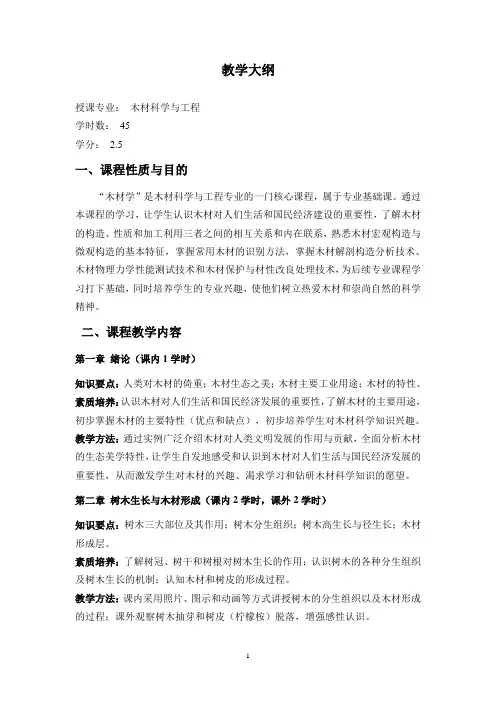
教学大纲授课专业:木材科学与工程学时数:45学分: 2.5一、课程性质与目的“木材学”是木材科学与工程专业的一门核心课程,属于专业基础课。
通过本课程的学习,让学生认识木材对人们生活和国民经济建设的重要性,了解木材的构造、性质和加工利用三者之间的相互关系和内在联系,熟悉木材宏观构造与微观构造的基本特征,掌握常用木材的识别方法,掌握木材解剖构造分析技术、木材物理力学性能测试技术和木材保护与材性改良处理技术,为后续专业课程学习打下基础,同时培养学生的专业兴趣,使他们树立热爱木材和崇尚自然的科学精神。
二、课程教学内容第一章绪论(课内1学时)知识要点:人类对木材的倚重;木材生态之美;木材主要工业用途;木材的特性。
素质培养:认识木材对人们生活和国民经济发展的重要性,了解木材的主要用途,初步掌握木材的主要特性(优点和缺点),初步培养学生对木材科学知识兴趣。
教学方法:通过实例广泛介绍木材对人类文明发展的作用与贡献,全面分析木材的生态美学特性,让学生自发地感受和认识到木材对人们生活与国民经济发展的重要性,从而激发学生对木材的兴趣、渴求学习和钻研木材科学知识的愿望。
第二章树木生长与木材形成(课内2学时,课外2学时)知识要点:树木三大部位及其作用;树木分生组织;树木高生长与径生长;木材形成层。
素质培养:了解树冠、树干和树根对树木生长的作用;认识树木的各种分生组织及树木生长的机制;认知木材和树皮的形成过程。
教学方法:课内采用照片、图示和动画等方式讲授树木的分生组织以及木材形成的过程;课外观察树木抽芽和树皮(柠檬桉)脱落,增强感性认识。
第三章木材宏观构造(课内6学时,课外8学时)知识要点:木材三切面的概念;木材的心材与边材;树木年轮与生长轮;早材与晚材;管孔;胞间道;木射线;轴向薄壁组织;木材的颜色、气味和纹理;树皮的作用与形貌特征。
素质培养:认识木材的主要宏观特征在三个切面上表现;熟悉木材的各种组织在木材横切面上的基本分布情况,掌握木材纹理和木材结构等概念,为木材宏观识别打下基础。
《木材科学与工程专业外语》课程大纲一、课程概述课程名称(中文):专业外语(英文):Professional English for Wood Science and Engineering 课程编号:14351073课程学分:3.0课程总学时:48课程性质:(专业课)二、课程内容简介(300字以内)木材科学与工程专业英语是在学习大学英语和相关专业课后而开设的一门专业核心课。
本课程内容主要包括木材结构、木材物理化学性能、木材力学性能、木材保护、木材干燥、胶粘剂、木质人造板等。
三、教学目标与要求《木材科学与工程专业英语》课程既为学生继续英语学习并同时接受专业训练提供帮助。
通过本课程的学习,要求学生既要掌握专业英语初步的“读写听”能力,同时巩固学过的专业知识,学习一些新的木材科学与工程知识。
本课程教学采用多媒体辅助教学,引导学生将英语学习和专业学习有机地结合起来,锻炼学生理解英文文献、正确翻译文献以及初步专业英语写作的能力。
四、教学内容与学时安排绪论Introduction(2学时)1. 教学目的与要求:了解木材资源、木材分类、木材特性等方面的英语知识;掌握本部分出现的英语单词。
2. 教学重点与难点:重点:掌握木材特性的英文专业术语;难点:一般性木材科技英文习惯表达法。
第一章Structure and Function of Wood/ 木材结构与功能(7学时)1. 教学目的与要求:了解不同尺度下的木材宏观构造特征的英语知识;掌握本部分出现的英语单词。
2. 教学重点与难点:重点:木材宏观构造特征的英文基本专业术语;难点:理解并掌握木材宏观构造特征的基本概念的英文描述。
第一节Biological Structure of Wood at Decreasing Scales /木材宏观构造(3学时)一、The tree/ 树木(0.2学时)二、Softwood and Hardwood/ 针叶树材和阔叶树材(0.2学时)三、Sapwood and Heartwood/边材和心材(0.3学时)四、Axial and Radial Systems/轴向和径向体系(0.3学时)五、Planes of Section/三切面(0.4学时)六、Vascular Cambium/维管形成层(0.2学时)七、Growth Rings/年轮、生长轮(0.4学时)八、Cells in Wood/木材细胞(0.4学时)九、Cell walls/细胞壁(0.4学时)十、Pits/纹孔(0.2学时)第二节Microscopic Structure of Softwoods and Hardwoods/针叶树材和阔叶树材微观构造(2学时)一、Softwoods/ 针叶树材(1学时)(一)Tracheids/管胞(0.3学时)(二)Axial Parenchyma and Resin Canal Complexes/轴向薄壁组织和树脂道(0.4学时)(三)Rays/木射线(0.3学时)二、Hardwoods/ 阔叶树材(1学时)(一)Vessels/导管(0.3学时)(二)Fibers /木纤维(0.2学时)(三)Axial Parenchyma/轴向薄壁组织(0.2学时)(四)Rays/木射线(0.2学时)第三节Juvenile Wood and Reaction Wood/幼龄材和应力木(1学时)一、Juvenile Wood/ 幼龄材(0.5学时)二、Reaction Wood/ 应力木(0.5学时)第四节The Properties of Wood Valuable in Identification /对木材识别有价值的木材物理性质(1学时)一、Color / 材色(0.2学时)二、Luster / 光泽(0.2学时)三、Grain and Texture/纹理和结构(0.4学时)四、Odor and taste / 木材的气味和滋味(0.2学时)第二章Chemical components of wood / 木材化学组成(2学时)1. 教学目的与要求:掌握木材化学成分的组成、定义。
2. 教学重点与难点:重点:掌握主要组成成分的英文专业术语;难点:记住各组成成分的英文名称。
第一节Primary Components / 主要成分(1学时)一、Cellulose/ 纤维素(0.5学时)二、Hemicelluloses/ 半纤维素(0.2学时)三、Lignin/木质素(0.3学时)第二节Secondary Components/次要成分(1学时)一、Extraneous materials / 抽提物质(0.5学时)二、Ash/ 灰分(0.5学时)第三章Physical Properties of Wood/ 木材物理性质(6学时)1. 教学目的与要求:掌握木材的物理性质:木材中的水分分类及其性质,纤维饱和点,吸湿滞后,比重和密度。
2. 教学重点与难点:重点:掌握描述木材物理性质概念的英文名称;难点:理解纤维饱和点,吸湿滞后等的英文解释。
第一节Wood -Moisture Relationships/木材与水(3学时)一、Moisture Content and Green Wood/ 含水率和生材(0.5学时)二、Fiber Saturation and Maximum Moisture Content/ 纤维饱和含水率和最大含水率(0.5学时)三、Water Vapor Sorption/水蒸气吸附(0.5学时)四、Liquid Water Absorption/吸水性(0.5学时)五、Dimensional Stability/尺寸稳定性(0.5学时)(一)Transverse and V olumetric Shrinkage/横向干缩和体积干缩(二)Longitudinal /纵向干缩(三)Relationship between Moisture Content and Shrinkage/含水率与干缩之间的关系六、Density and Specific Gravity/密度和比重(0.5学时)第二节Thermal Properties/热学性质(2学时)一、Thermal Conductivity/ 导热系数(0.5学时)二、Heat Capacity/ 热容(0.5学时)三、Thermal Diffusivity/ 热扩散系数(0.5学时)四、Coefficient of Thermal Expansion/ 热膨胀系数(0.5学时)第三节Electrical Properties/电学性质(1学时)一、Direct-current (DC) electrical properties of wood / 木材的直流电性能/ (0.5学时)(一)Resistivity / 电阻率(二)DC Dielectric Constant/ 介电常数二、Alternating-current (AC) characteristics of wood / 木材的交流电性能(0.5学时)(一)AC Dielectric Constant and Related Properties/ 介电常数和相关性质(二)Impedance/ 阻抗第四章Mechanical Properties of Wood/ 木材力学性质(7学时)1. 教学目的与要求:掌握影响木材力学性质的因素。
2. 教学重点与难点:重点:掌握描述木材力学性质概念的英文名称;难点:理解木材力学性质的英文描述。
第一节Orthotropic Nature of Wood/木材的各向异性(0.5学时)第二节Elastic Properties/弹性性质(0.5学时)一、Modulus of Elasticity/ 弹性模量二、Poisson’s Ratio/ 泊松比三、Modulus of Rigidity/ 剪切模量第三节Strength Properties/力学性质(2学时)一、Common Properties / 主要力学性质(1.5学时)(一)Modulus of rupture /断裂模量(二)Work to maximum load in bending/ 弯曲最大承载力(三)Compressive strength parallel to grain / 顺纹抗压强度(四)Compression perpendicular to grain/ 横纹抗压强度(五)Shear strength parallel to grain/ 顺纹抗剪强度(六)Impact bending(七)Tensile strength perpendicular to grain/ 横纹抗拉强度(八)Tensile strength parallel to grain/ 顺纹抗拉强度(九)Hardness/ 硬度二、Less Common Properties / 次要力学性质(0.5学时)(一)Toughness/ 韧性(二)Creep and duration of load/ 蠕变和加载时间(三)Fatigue/ 疲劳(四)Nanoindentation hardness/纳米亚痕硬度(五)Fracture toughness/ 断裂韧性第四节Natural Characteristics Affecting Mechanical Properties /影响力学性质的因素(4学时)一、Specific Gravity / 比重(0.5学时)二、Knots/ 节子(0.5学时)三、Slope of Grain/ 斜纹理(0.5学时)四、Reaction Wood / 应力木(0.5学时)五、Extractives/ 抽提物(0.5学时)六、Effects of Manufacturing and Service Environments/ 环境影响(1.5学时)(一)Moisture Content/ 含水率(二)Temperature/ 温度第五章Drying of Wood/ 木材干燥(5学时)1. 教学目的与要求:掌握影响木材干燥方法和干燥缺陷。
2. 教学重点与难点:重点:掌握木材干燥方法和干燥缺陷的英文名称;难点:准确理解各种干燥缺陷的英文描述。
第一节Drying of Wood/木材干燥(2学时)一、Moisture Content / 含水率(0.5学时)二、Reasons for Moisture Content Control / 控制含水率的原因(0.5学时)三、Drying Methods for Lumber and Other Solid Wood Products/ 锯材和其他实木制品的干燥方法(1学时)(一)Air Drying/ 气干(二)Kiln Drying/ 室干第二节Drying Defects /干燥缺陷(3学时)一、Shrinkage Related Defects/ 干缩引起的缺陷(0.5学时)二、Fungus Related Defects/ 真菌引起的缺陷(0.5学时)三、Extractive Related Defects/ 抽提物引起的缺陷(0.5学时)四、Factors Affecting Drying Rate / 影响干燥速度的因素(0.5学时)五、Special Drying Methods/ 特种干燥方法(0.5学时)六、Drying of Other Forest Products/ 其他产品干燥(0.5学时)第六章Adhesion and Adhesives / 胶合与胶粘剂(7学时)1. 教学目的与要求:了解胶合机理;掌握影响木材胶合的因素。